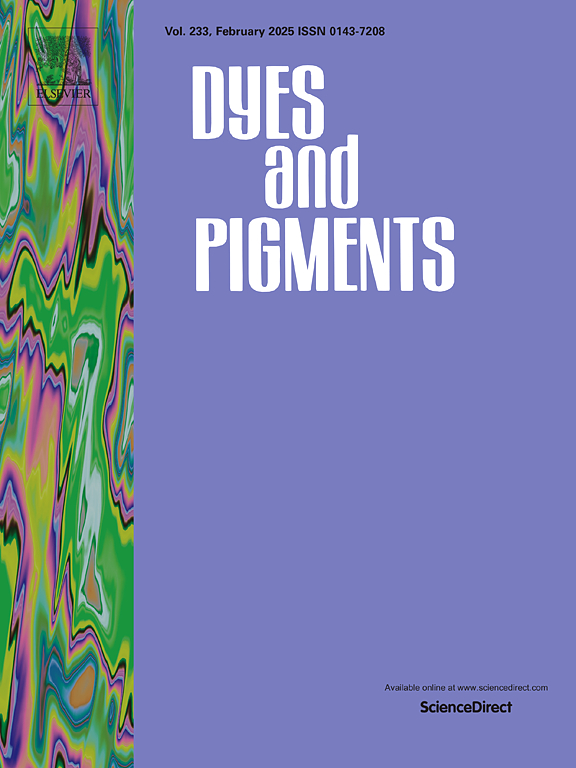Synthesis and structure study of coumarin 6 modified Zn-MOF and its application in artificial light capture system
IF 4.1
3区 工程技术
Q2 CHEMISTRY, APPLIED
引用次数: 0
Abstract
With the recent advancements in materials science, solar energy as a kind of clean energy source has gained increasing importance, and the research in solar cell technology has become a prominent area. In particular, the development of photoelectric conversion materials has attracted significant attention. In this paper, a novel two-dimensional Zn-based metal-organic framework (Zn-MOF) with 4 × 4 grid wave layer structure was synthesized using flexible 1,3-phenyldiacetic acid (H2mpda) and rigid 3,5-bis (triazolium) pyridine (btyp) ligands. The fluorescence emission spectrum of Zn-MOF aligns with the UV–visible absorption spectrum of coumarin 6 (CM6), enabling their use as donor and acceptor for fluorescence resonance energy transfer (FRET) to construct an artificial light harvesting system (ALHS). Compared to Zn-MOF, Zn-MOF@CM6 demonstrates significantly larger surface area (7.4 m2/g), energy transfer efficiency (ΦET) of 47.7 %, and photocurrent on/off ratio (Ilight/Idark) of 50:1, which far exceeds previously reported values in literature. Interestingly, during the battery charge and discharge test, the diode of Zn-MOF@CM6 was observed to emit light. Zn-MOF@CM6 not only expands the application of MOF materials in artificial light harvesting systems, but also provides a new perspective for solar energy utilization and solar cell construction.
香豆素6修饰Zn-MOF的合成、结构研究及其在人工光捕获系统中的应用
随着近年来材料科学的进步,太阳能作为一种清洁能源越来越受到人们的重视,太阳能电池技术的研究也成为一个突出的领域。特别是光电转换材料的发展引起了极大的关注。本文采用柔性的1,3-苯二乙酸(H2mpda)和刚性的3,5-双(三唑)吡啶(btyp)配体合成了具有4 × 4网格波层结构的二维锌基金属有机骨架(Zn-MOF)。Zn-MOF的荧光发射光谱与香豆素6 (CM6)的紫外-可见吸收光谱一致,可以作为荧光共振能量转移(FRET)的供体和受体,构建人工光收集系统(ALHS)。与Zn-MOF相比,Zn-MOF@CM6具有更大的表面积(7.4 m2/g),能量传递效率(ΦET)为47.7%,光电流开/关比(light/Idark)为50:1,远远超过先前文献报道的值。有趣的是,在电池充放电测试中,观察到Zn-MOF@CM6的二极管发光。Zn-MOF@CM6不仅拓展了MOF材料在人工光收集系统中的应用,也为太阳能利用和太阳能电池建设提供了新的视角。
本文章由计算机程序翻译,如有差异,请以英文原文为准。
求助全文
约1分钟内获得全文
求助全文
来源期刊

Dyes and Pigments
工程技术-材料科学:纺织
CiteScore
8.20
自引率
13.30%
发文量
933
审稿时长
33 days
期刊介绍:
Dyes and Pigments covers the scientific and technical aspects of the chemistry and physics of dyes, pigments and their intermediates. Emphasis is placed on the properties of the colouring matters themselves rather than on their applications or the system in which they may be applied.
Thus the journal accepts research and review papers on the synthesis of dyes, pigments and intermediates, their physical or chemical properties, e.g. spectroscopic, surface, solution or solid state characteristics, the physical aspects of their preparation, e.g. precipitation, nucleation and growth, crystal formation, liquid crystalline characteristics, their photochemical, ecological or biological properties and the relationship between colour and chemical constitution. However, papers are considered which deal with the more fundamental aspects of colourant application and of the interactions of colourants with substrates or media.
The journal will interest a wide variety of workers in a range of disciplines whose work involves dyes, pigments and their intermediates, and provides a platform for investigators with common interests but diverse fields of activity such as cosmetics, reprographics, dye and pigment synthesis, medical research, polymers, etc.
 求助内容:
求助内容: 应助结果提醒方式:
应助结果提醒方式:


